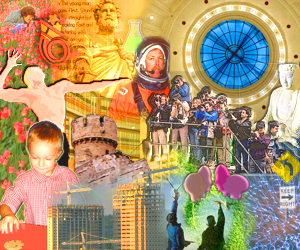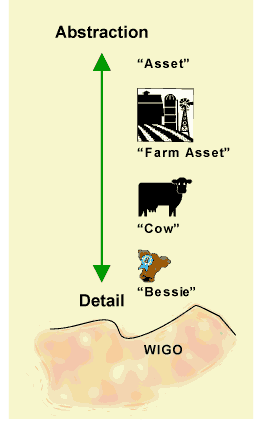Critical Thinking for Psi Dreamers
©2007 Gloria Sturzenacker
 In the 2005 PsiberDreaming Conference (PDC), I presented a paper saying that generalized skepticism about psi is passé—there’s plenty of reason to accept that psi connections occur, and it’s high time for skeptics of the knee-jerk type to open their eyes to the evidence for psi. But I also suggested that many of us psi dreamers actually need to become more skeptical about specific psi connections. In the 2005 PsiberDreaming Conference (PDC), I presented a paper saying that generalized skepticism about psi is passé—there’s plenty of reason to accept that psi connections occur, and it’s high time for skeptics of the knee-jerk type to open their eyes to the evidence for psi. But I also suggested that many of us psi dreamers actually need to become more skeptical about specific psi connections.
In fact, clear and thorough thinking is vital to the entire range of what psi dreamers are likely to want to accomplish:
-
Understanding the nature of both dreams and psi
-
Recording dreams clearly and thoroughly
-
Avoiding logical errors
-
Winnowing out the weak cases
-
Identifying psi content and its waking-life correlates more accurately and with greater specificity
-
Being convincing to skeptics (at least the ones we care about!) and persuasive to those in a position to make use of psi information
Critical thinking might sound like a cold, intellectual way to approach the almost magical richness of dreams. But it simply means “thinking about thinking”—becoming conscious of our biases, our barriers to perceiving and understanding, our worldviews. Critical thinking can be applied to the entire “PEDA process”: perception, evaluation, decision-making, and action—pretty much our entire experience, both waking and within dreams.
Framework 

My background in teaching critical thinking is from a series of courses at Pace University in New York City, developed and taught by psychologist Rachel Lauer[2]. Her framework for teaching critical thinking combines general semantics (GS) and developmental psychology.
Regarding the first of those two ingredients, consider this definition:
“General Semantics” refers to a general system of evaluation—that is to say, a systematic methodology for individuals to use in understanding how they relate to the world around them, how they react to this world, how they react to their reactions, and how they adjust their behavior accordingly. In other words, you could say that general semantics is concerned with how well we integrate the world “out there” (outside our skin) with the world “in here” (inside our skin).[3]
That sounds a lot like dreamwork to me.
The developmental psychology aspect of Lauer’s framework is this: She identified nearly a hundred meta-concepts, or “metacepts,” that individuals learn at five different stages (“epistemes”) of development over a lifetime, and that civilization has learned over history. (You can download a PDF-format list of the metacepts here.) I often refer to these metacepts as “thinking skills,” although Rachel told me that was too simplistic. Indeed, she defined them as “universal concepts that structure, order, and relate.”(In class, there was plenty of debate over why Lauer had pegged certain metacepts as arising in certain stages. I don’t consider those issues important for the current topic.)
Each of the five stages constitutes a worldview, a paradigm. They occur successively—one must past through one stage to get to the next—but the metacepts from each stage are retained as a person progresses to the next stage. A person won’t comprehend much from a stage not yet reached. These stages are:

Stage 1: Sensing, Feeling, Egocentrism[5] – (Birth through childhood) “Truth” is whatever I perceive, think, or feel.
Stage 2: Classification, Dualism, Authority – (Preadolescence) “Truth” lies in the nature of things—known through classification and proper use of language.
Stage 3: Objective Science, Measurement, Relating Things to Each Other – (Adolescence into adulthood) “Truth” lies in relations among things; known through scientific research.
Stage 4: Subjective Science, Humanism – (Adulthood [perhaps]) “Truth” lies in relations among observers, how and what is observed, and is ultimately uncertain.
Stage 5: Unifying – (Adulthood [perhaps]) “Truth” lies in experience of unity, oneness of all in the universe.
Progression through the stages isn’t particularly even. A person might be in a rather advanced stage regarding one aspect of life or knowledge, and in a much earlier stage regarding another. And moving from one stage to the next may happen in fits and starts and flashes of new ways of seeing things.
Now let’s apply Lauer’s framework to the psi dreamer’s tasks.
Understanding the Nature of Both Dreaming and Psi  
This is handy place to start because it calls on both Stage 1 and Stage 5.
The two often sound similar to the student of Lauer’s framework. The distinction is that Stage 1 is close to the undifferentiated identity an infant has with its surroundings, while Stage 5 is a sense of oneness culminating from all that one has learned from progressing through Stages 1 to 4.
In Lauer’s framework, Dreaming and fantasizing are a metacept first encountered in Stage 1. Other Stage 1 metacepts include Sensing (as in visualizing, moving, weighing, smelling); Symbolizing (as in imagery, dance, music, drama, crafts); Projecting; Transferring images, as in metaphor; Emoting; Associating freely; and Wishing and wanting. Any of these can be done with more sophistication as the skills of later stages are acquired; music can be written with orchestration, for example. But to hum a series of notes or bang on a drum rhythmically requires only a Stage 1 mindset. Dreaming, of course, isn’t limited to the use of Stage 1 skills; it only begins there.
Stage 5 seems the most likely paradigm within which we may someday truly understand the nature of psi—whether its processes turn out to rely on wormholes in the quantum foam, relativistic effects of consciousness moving faster than the speed of light, or some other reality about which we’re still, now, only able to speculate. Even for people who’ve reached Stage 5, it’s generally a fleeting experience in meditation or peak performance. Lauer described Stage 5 as being beyond words, so it’s not surprising that she named only a few metacepts of Stage 5: Perceiving oneness, Perceiving rhythms, Conceiving the cosmos, Resolving opposites.
Recording Dreams Clearly and Thoroughly 
A core idea in general semantics is Time-binding: perceiving and using past-present-future (Stage 3), and that’s something that dream journaling accomplishes for us. In GS, time-binding refers to the uniquely human ability to build on knowledge of past generations because the knowledge been passed down through language. But a dream journal allows us to pass knowledge of our own dream experience on to our later selves—knowledge otherwise so ephemeral that we easily forget it within moments of wakening.
Basic dream journaling draws heavily on a handful of the metacepts that first arise in Stage 2: Listing and describing; Remembering, copying, and recording in various modalities; and Identifying and naming.
Stage 2 is distinguished by the emergence and use of language and by Categorizing, classifying, and conceptualizing. Categories are abstractions, and every word denotes a category: “cow” means the category of animal consisting of “the mature female[s] of cattle,”[6] without reference to details such as breed, size, color, or one cow’s name, Bessie.

Language gives us a more efficient way of sharing our experiences with others, but it also creates what I call “a wall of words” between us and our experience of the “process world” or, to use another GS term, WIGO (What Is Going On)—in this case, the dream. So in making a verbal record of a dream, we encounter one of the fundamental insights of general semantics: the different levels of abstraction at which words operate. Making sketches and diagrams will capture some of what words leave out, but even the most accomplished artwork is also an abstraction of what inspired the artist.
We can’t escape the losses of abstraction altogether. However, with Consciousness of abstracting (Stage 3), we can devise ways to minimize them. I structure my journal in a way that reminds me to be as concrete as I can, with specific places to record the feelings, my last thoughts before sleep, and memories and ideas I associate with the dream content.
Avoiding Logical Errors 
Along with language, logic arises in Stage 2. If we don’t hone our logic skills, a lot can go wrong in our thinking about psi.
At least three types of error can occur in Categorizing and classifying (Stage 2).
-
Categorizing too strictly (“Sane people aren’t psychic.”)
-
Categorizing too loosely—overgeneralizing (“He helped me find my lost keys. He’s psychic.”)
-
Mixing levels of abstraction (“I had a dream and a nightmare.”)
Psi, which functions outside of linear time, wreaks havoc on our skill at Deducing cause and effect (Stage 2) and Sequencing events, causes and effects (Stage 3). But these metacepts still apply to much of what we do with psi dreams and how we go about interpreting them. The old logical fallacy known by the Latin phrase post hoc, ergo procter hoc is the error of believing ”It comes after, therefore it’s because of.” We’re tempted to commit the inverse error: thinking that if our dream comes before a waking-world event that matches it in some way, it automatically means the dream had a psi origin.
Mastering logical syllogisms (Stage 2) is one of the metacepts most commonly associated with critical thinking. A syllogism is a set of statements (“premises”) and the conclusion drawn from them. Figuring out whether a specific syllogism should be believed, however, is much more complex, because the syllogism may be valid or invalid—“valid” means that if the premises are true, the conclusion will be, too—but whether the premises are true or false is a separate matter. Formal logic also covers other uses of language such as sentence structure and “If-then” statements. There’s not enough space here to explore any of these more deeply, but they’re so important in everyday life—and so easily misused either innocently or to mislead and manipulate—that they’re worth studying thoroughly.
Mapping—distinguishing among facts, inferences, opinions, and judgments (Stage 3) is crucial to research of any kind. In our work, the factual starting points are the dream record and our objective knowledge about waking reality. We make inferences about relationships between the two sets of facts. The more metaphorical the relationship and the farther outside our personal experience the dream’s waking-life correlate is, the harder it is for us to establish a psi connection as being a fact, or “truth.”
Winnowing out the weak cases 
An overarching metacept of Stage 3 is Evaluating evidence, something that often gets short shrift when we get either excited by or unnerved by a psi dream. I’ve come to think of this as the need to do “due diligence.” That term is used in business and legal contexts to mean doing careful research and documentation before a transaction, in order to avoid causing or incurring harm.
What might mark a correspondence between dream and waking life as a weak case for psi is any evidence of a normal cause-and-effect relationship. Could the dream content in question be day residue—matched to recent events, feelings, physical conditions, or media exposures in waking life, even those barely noticed? Could an intuitive response to waking information—such as a loved one’s facial expressions, or the message “between the lines” of a boss’s recent rant—have triggered the dream? Does the content metaphorically represent unresolved issues in the dreamer’s life, or unfulfilled wishes, or logical projections of how current conditions could play out in the future?
A yes answer to any of these doesn’t automatically rule out psi, but it does mean we need very good other reasons to think psi is involved. Psi and dreams are too diverse to set a specific standard for Correlating (Stage 3) the dream content with a similar waking-life event. But a model to keep in mind might be the way forensics experts require a certain number of whorls and loops in a fingerprint pattern to be matched before they will declare a positive identification.
Improving Psi Accuracy and Specificity 
Metacepts from every stage can help us here.
If the workings of psi are most likely to be understood at Stage 5, then likely the most direct way to sharpen psi perception is through regular practices, such as meditation, that go beyond the wall of words to Perceiving oneness.
Other improvements can be gained by Observing systematically (Stage 3); the main instrument will be your journal. If possible, type and store at least the verbal portion of your journal on computer (whether as separate files or in a dream database). This will make it much easier to search, analyze, and annotate.
Take advantage of your journal’s Time-binding (Stage 3) function to highlight repetitions of themes and images that might indicate psi sensitivity to a specific subject. Conversely, a journal search can confirm the rarity of a dream image, which is sometimes a sign of psi. Dream content that strikes me as odd sends me to Google and other sources, following my curiosity and Researching (Stage 3) meanings and events related to the dream image or words. Many striking and complex psi connections have revealed themselves this way.
Categorizing (Stage 2) settings, feelings, qualities, and connections in the dream facilitates Comparing and contrasting them (Stage 3), with the possibility of Perceiving patterns of thought (Stage 4) that mark a dream experience as psi-inspired. Patterns might also be found in the day residue, highlighting conditions that make you especially sensitive to psi.
Another general approach to improving psi accuracy and specificity is Dialoguing and exchanging (Stage 3)—engaging a dream group or just yourself with thought experiments and with questions about specific dream content. These can expand the meaning enfolded in a metaphor or the real context of a non-metaphorical psi perception. That’s the purpose of the “If this were my dream” stage in both the Ullman Method and the Taylor Method of group dreamwork. It gets group members Empathizing (Stage 3) and Projecting (Stage 1) new associations onto the dream that’s been shared.
Other ways to dialogue with yourself and the dream:
-
Try Symbolizing (as in imagery, dance, music, drama crafts) (Stage 1) the possibly psi content.
-
For Deducing cause and effect (Stage 2), ask why: Why did my mind choose that day residue out of the countless things I’ve seen and done recently? Out of the infinite number of events and objects in the universe, why was I sensitive to this apparently psi input. Keeping in mind that any future event you tune into is the effect of multiple causes, incubate a dream to view the causes.
-
Practice Shifting categories (Stage 3). Try this out with a group: Hold up an object, such as a plastic drinking cup. Ask the group: “How many uses can you think of for this?” (Say only “this,” not “cup.”) Try the same approach with a dream image.
-
Shift your focus between structures and processes. If you’ve dreamt of a dilapidated house, what does the dream hint was the process by which the house got into such bad shape? If you’ve dreamt of a family squabbling, what are the power structures within that family?
Being Convincing and Persuasive 
Frankly, I doubt that anyone can fully convince another person that psi exists. Psi defies the hard-won understanding of the rules of the physical plane that we started acquiring when we entered it as newborns. So maybe it’s natural that true conviction about psi seems to require direct experience not unlike religious conversion, felt bodily at Stage 1, where “Truth is whatever I perceive, think, or feel.”
It’s not at all clear what conditions are necessary for any given person to have a direct experience of psi: Stage 5 mystical experience? Stage 4 intellectual understanding that all things are related? Stage 3 laboratory evidence? Stage 2 acceptance of a church’s or community’s belief system? A Stage 1 desperate need for intervention on health or some other issue? Maybe any one of these.
Lauer’s epistemic framework probably can’t help us provide a skeptic with that direct experience, but it can help us present information about psi in ways it will be best understood. Persuading—influencing, manipulating is actually a Stage 3 metacept, but two other metacepts are especially useful in making that happen: Perceiving patterns of thought (Stage 4)—in this case, recognizing the episteme from which the person we’d like to influence views the subject of psi...and then Empathizing (Stage 3) with that worldview. Keep in mind that a person won’t grasp ideas from a stage they’ve never reached.
One of the social circles I spend time in consists of people with strong Stage 1 and Stage 2 tendencies. Their interests are concrete and practical. I’m cautious about talking about psi or even dreams with members of this culture—wisely so, I think. But when I do, their practicality leads me to use several lower-stage appeals. In their daily lives, this group encounters extremely variable conditions, so that they often need to use Trial and error experimenting (Stage 1) to address situations, and they become adept at Intuiting (Stage 2) conditions with the help of past experience. So I might point out in conversation that psi has a lot in common with that sort of intuition, and that psi dreams frequently deliver practical ideas, such as the design of a tool. From Stage 2 with this same audience, I might describe the Stage 2 procedural aspects of journaling that will capture the practical ideas from dreams.
If you’re speaking with Stage 2 people who have lots of arguments against the possibility of psi, you can use logic to argue the other side. The care with which you maintain your journal and document psi instances (those recording and describing skills from Stage 2) may carry some weight with Stage 2 thinkers. If the arguments you’re hearing are heated but logically weak, your skeptic is probably a Stage 1 thinker in Stage 2 clothing.
Although Stage 3 is where the scientific method takes shape, laboratory data doesn’t seem to be very convincing to strong psi skeptics from the sciences.[7] Just recently, I came upon a quote from psychologist Lawrence LeShan that suggests why. He drew a lesson for parapsychology research from the physics research of the early 20th century:
...in those days physicists did not content themselves collecting samples and measuring them promiscuously. They did not go from one place to another making statistical studies of the intensity of the effect. Instead, they succeeded in finding circumstances under which the phenomenon became enhanced and became controllable. In other words, they were very specific, and by being specific, persistent, and judicious in their selection of experimental conditions, they transcended the need for statistical arguments and probability estimates of validity; [and] they uncovered clear evidence of the existence of the effect.
To many laypersons, real-life stories of psi are more engaging than statistics, and putting a strong narrative together can involve Stage 3 skills just as laboratory studies do—in this case, Sequencing events, causes and effects; Synthesizing, combining and recombining; and Selecting-omitting-emphasizing and being aware of same (consciousness of abstracting). Lab scientists may dismiss this sort of evidence as anecdotal, but as Dennis Schmidt has pointed out, journaling is the fundamental research tool in some scientific fields, such as astronomy.[9]
The popularization of relativity theory, quantum mechanics, and the so-called new sciences in recent years makes Stage 4 metacepts accessible to many more people. Acknowledging role of observer and observing instruments in all perceptions is where a theory that explains psi becomes possible, and that’s good news. LeShan said that theory is the other thing needed to convince scientists:
No amount of empirical evidence, no mere collection of facts, will convince all scientists of the veracity and the significance of parapsychologists’ reports. He must provide some sort of model…he must advance bold constructs—constructs connected within a texture of rationality—in terms of which ESP [extrasensory perception] can be theoretically understood.[10]
Conclusion
The work of convincing people that psi exists is the work of Breaking down boundaries and limits (Stage 3) of belief. For a phenomenon as startling as psi, this work must be built on rigorous and creative uses of the skills and concepts we’ve learned at each stage of our development.
When I first received an invitation to Rachel Lauer’s classes, I was puzzled to read her claim that critical thinking could facilitate paradigm shift. In those days, I thought of critical thinking mainly as logic. But shifting paradigms indeed is what occurs as an individual or a civilization progresses through the stages that constitute Lauer’s framework of critical thinking. So let’s use our knowledge of psi and the skills and concepts of a lifetime toward Transforming—as in synergizing and altering patterns of consciousness (Stage 4). Let’s help shift the paradigm.
Inner Guide Mapping symbols © copyright 1998 by Gloria Sturzenacker.
[1] Gloria Sturzenacker, “Does Scientific Honesty Still Require Skepticism About Psi?” presented in the International Association for the Study of Dreams’ 2005 PsiberDreaming Conference, online.
[2] Rachel Lauer, Ph.D., founded and directed the Straus Thinking & Learning Center at Pace University after retiring from the New York City Board of Education as chief school psychologist. She built her framework of epistemes and metacepts on the work of Alfred Korzybski (founder of general semantics), J.S. Bois, and Jean Piaget. Dr. Lauer died in 2001, and the Straus Center was later closed. Montague Ullman, the pioneer in both group dreamwork and laboratory studies into dream telepathy, was on the Straus Center’s board of directors.
[4] Rachel M. Lauer, “A Meta Curriculum Based Upon Critical Thinking,” ETC. A Review of General Semantics, Vol. 53, No. 4, Winter 1996-7, Institute of General Semantics, pp. 374–387.
[5] The names of the stages vary in different materials that Dr. Lauer distributed. I’m labeling them in a composite way.
[7] The basis for this discouraging statement is in the chapter titled “Field Guide to Skepticism,” in Dean Radin, The Conscious Universe: The Scientific Truth of Psychic Phenomena, HarperEdge (San Francisco: 1997).
Close window to return to the bulletin board
back to top
|








